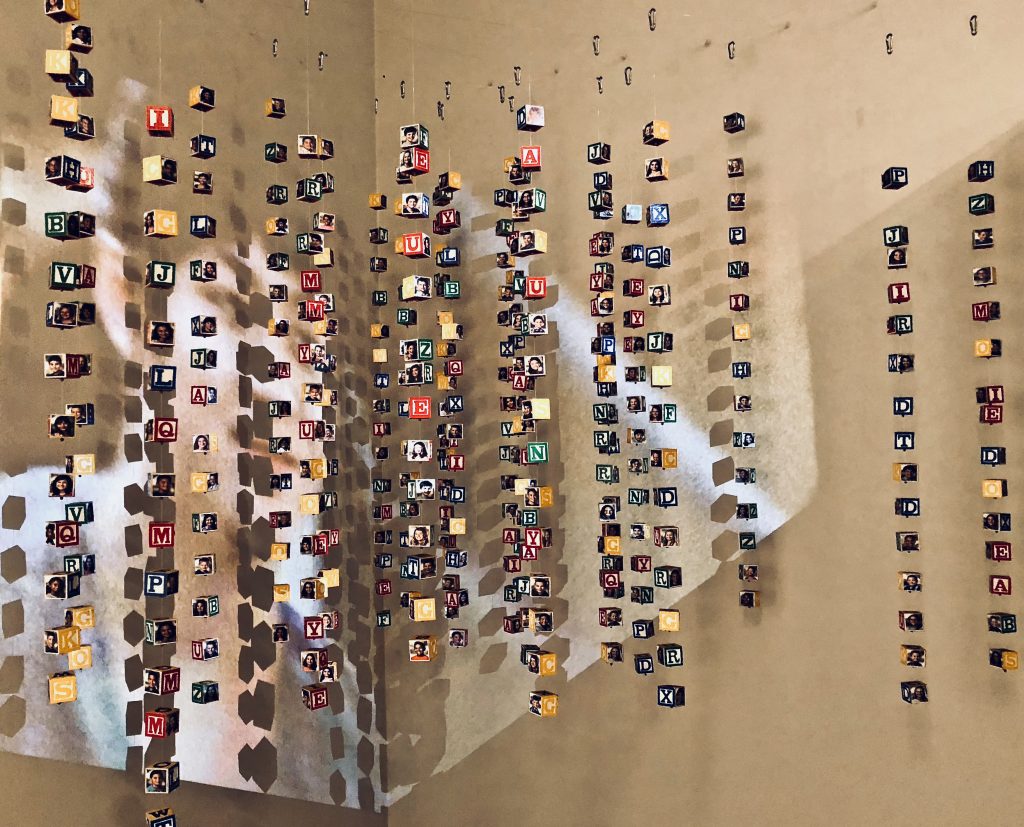Award-winning independent film maker Jonathan Fung’s 2018 video art installation Prey, on exhibit now through Sept. 21 at the Natalie and James Thompson Gallery at San José State University, was created to raise awareness of human trafficking — specifically child trafficking.
Prey is made up of 350 children’s wooden alphabet blocks, each with the photo of a child on it, symbolizing an innocent childhood potentially stolen through trafficking. Backed into a gallery corner, like a trapped child, the blocks dangle from overhead lines like mobiles. Fifteen blocks are attached to each of the more than 20 vertical lines that hang along two adjacent walls, meeting in the corner.
A two-minute film of a teenage girl playing on a merry-go-round is projected onto the blocks and the walls behind them. The film loops, cycling endlessly like a nonstop merry-go-round. Fung, who has lived in Santa Clara for 16 years, filmed the action with his teenage daughter at a city park.
“It symbolizes that children are our most valuable resource and should be protected instead of being a commodity that is for sale,” said Fung. “There is a duality also symbolizing the vicious cycle of violence and exploitation that never ends for some girls.”
The average age for girls and boys entering into sex trafficking is believed to be 11 to 14. And, according to the Santa Clara County Human Traffic Task Force, California is one of the largest sites of human trafficking in the United States.
Fung is a lecturer in the Art and Art History Department at SJSU, and Prey is part of the department’s Reasons & Reverie exhibition, which showcases the photography talents of SJSU faculty. Called provocative and stimulating, the exhibition opened Aug. 28 with artist talks followed by a reception drawing more than 100.
Prey features eight artists displaying a range of media, style and technique: Eliana Cetto, Binh Danh, Victoria Heilweil, Dan Herrera, Robin Lasser, Valerie Mendoza, Yvonne Williams and Fung, who teaches photography through a social justice and narrative lens.
“In the past 10 years, I have been using art as a platform to raise awareness and to initiate call to action for people that don’t know about trafficking,” said Fung.
Although Prey is site specific — tailored to the SJSU exhibition and gallery space, it is adaptable to other galleries or museums.
The Thompson Gallery at SJSU is in the Art and Art History Building, # 127. Gallery Hours, (while campus classes are in session) are Monday – Friday, 10 a.m. to 4 p.m., plus Tuesday evenings 6 p.m. to 7:30 p.m.; for information, phone (408) 924-4330.
Fung’s earlier art focusing on human trafficking includes the public art project Peep, which was installed in San José at Parque de los Pobladores during Super Bowl 50, hosted in 2016 at Levi’s Stadium, Santa Clara. Read about Peep at here.
Fung’s narrative short film Hark, also about trafficking, premiered in June of 2012 at Santa Clara University and has won several awards. The 15-minute fictional film is the story of a man’s moral dilemma as he chooses whether to save his own life or to risk that of another. To view Hark online or arrange for a screening, visit www.harkthemovie.com.
The Community Solutions 24 Hour Crisis Line is 1 (877) 363-7238. The National Human Trafficking Hotline is 1 (888) 373-7888.
